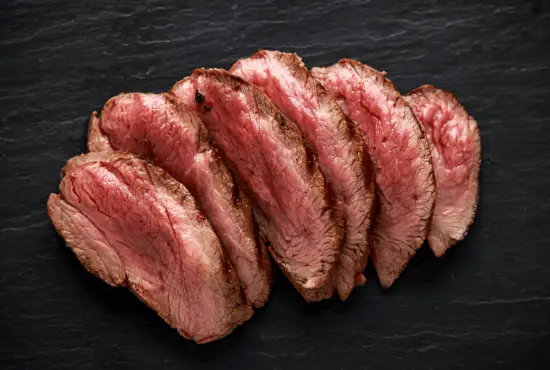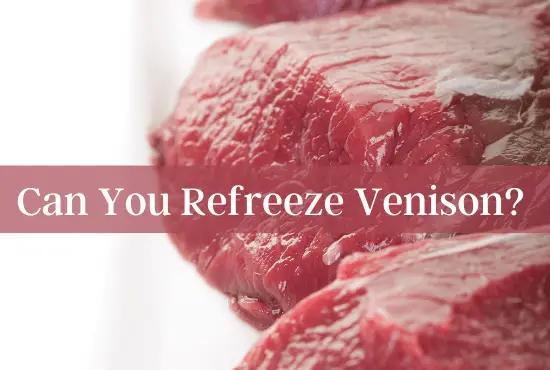Refreezing Venison meat might get tricky as you do not want to lose the water retention, taste, and healthy nutrition that it holds. Also, a thawed Venison requires a little bit more handling precautions before refreezing it.
So, it gets a matter of concern if, can you refreeze venison?
You can refreeze venison by following the simple preventive method for it. Make sure to defrost the meat properly if it is in raw form. It is best to thaw venison in the fridge to avoid spoiling. Wrap the venison in aluminum foil for water retention and then pack it in Ziploc freezer bags. Place venison at the bottom of the freezer for a consistent temperature.
Venison meat is the tastiest, and it gives your body a bundle of strength. Let’s look at some basic preventive measures for refreezing so you can make venison last longer.
Table of Contents
Is It Safe To Refreeze Venison?
According to the USDA, like any other meat, you can refreeze venison safely. There can be no health issues while eating a lump of refrozen venison meat. However, frequent exposure to low temperatures can alter the taste and quality to some extent.
Besides, the refreezing of venison depends upon what thawing method you applied for defrosting it. If you thaw your meat in the refrigerator, you can store it back in the freezer. As inside the fridge, the chances of bacterial contamination are minimum so, the rate of spoilage is relatively low.
But, if you left your venison out on the countertop, it cannot freeze well again. Increasing its stay at room temperature allows the microbes to spread rapidly. As an outcome, the meat is not safe to go another round of freezing. Microwaving meat for thawing also leads to similar consequences.
For a better freezing result, wrap your meat tightly in safe packaging so no air or bacteria can contact it. Ice in the freezer also keeps the bacteria away that might spoil the freshness and flavor of the meat.
How To Refreeze Thawed Venison?

Whether it’s a steak or any other dish, people enjoy venison for its distinct rich flavors. So, to retain the tenderness and juiciness of your meat, a proper refreezing process holds importance.
Here are a few steps that you must follow for refreezing your venison meat:
- Firstly, allow the cooked meat to cool down before placing it in the freezer.
- For uncooked meat, let it first fully thaw. An uneven defrosted venison can lead to freezer burns resulting in the loss of taste.
- Do not freeze the meat if you leave it for more than two hours in an open environment.
- Wrap the venison in aluminum foil. It is preferable as it keeps the moisture of the meat intact.
- Now, transfer it into an airtight container or a Ziploc bag and remove the excess air with a vacuum sealer.
- It will work as a shield and prevent the meat from absorbing other food flavors.
- The best way to refreeze venison is by dividing it into small pieces first. It will save you from unnecessary thawing in the future.
- Next, place the meat in a safe corner inside the freezer to provide a constant temperature.
- The last step is to label the bag or container. So you can take note of the best before date and consume venison in its best quality
How Long Can You Refreeze Venison?
You can refreeze venison for an extended period of almost six months. It is a piece of good news for venison lovers. However, certain limitations can impact the overall freezing span.
Venison meat is hard to get than other goat or cow meat. Refreezing makes it very convenient to eat it whenever you want, as you can refreeze it for such a long time.
How Many Times Can You Refreeze Venison?
As freezing significantly reduces the richness of flavor, it is not a good idea to refreeze venison continuously. Still, the meat will be consumable and devoid of any threatening health complications.
But, it is best to utilize your venison after initial freezing and thawing. The longer you keep it, the more its texture gets affected. Freezing causes the formation of ice crystals that can lead to loss of moisture in the meat. As a result, it becomes stale and hard to chew.
To overcome such a situation, freeze your meat in small portions rather than all together. By performing this step, you can easily control the amount you want to thaw and use. It will also eliminate the repeated cycle of storing and thawing the meat.
Furthermore, it will also decrease the possibility of air contamination. So, you will be left behind with venison meat that is safe for eating.
Conclusion
Refreezing venison is very easy, and it is entirely safe and healthy. But, it can change the taste and quality of meat to a certain degree.
Therefore, you must follow all the steps ranging from correct defrosting to placing it in the freezer. Ensure to wrap your meat securely before leaving it for long-term storage.
Don’t exceed the instructed time limit of refreezing your venison. Keeping it for a prolonged duration will make your meat dry and unhealthy to eat.



